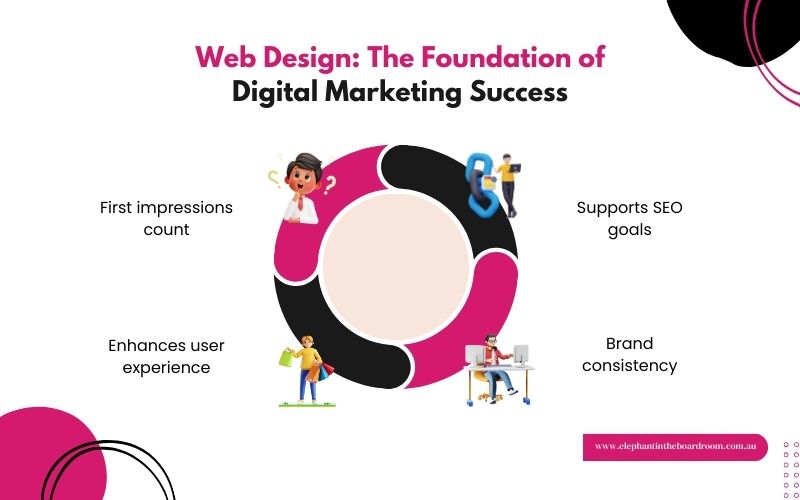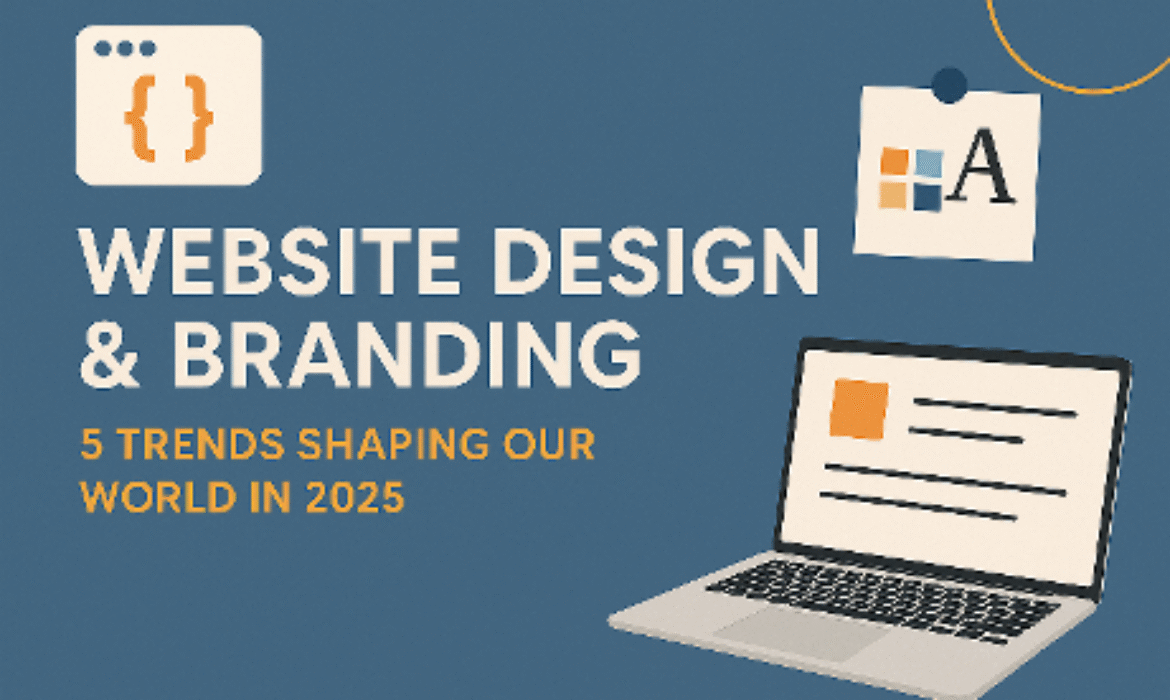Website design and branding have never been more critical. By 2025, consumers expect a seamless, polished online experience that reflects a brand’s identity. A clear, modern website builds trust and sets small businesses apart. As UXPin emphasizes, customers “want to see consistency, even down to a product’s typography, colors, and microinteractions”. This means sites must not only look good but reinforce brand values at every click. The rise of mobile traffic, AI, and stricter accessibility laws also mean a lagging site or inconsistent branding can cost customers — and even invite legal risk.
- Modern minimalist homepage layouts: Clean, simple homepages (like the laptop mockup above) are on trend. Designers use ample whitespace and balanced typography to focus attention on key calls-to-action. Emphasizing “negative space” and minimal design is a 2025 best practice. For example, a minimalist layout avoids clutter so that navigation and messaging stand out clearly.
A modern, minimalist homepage layout (shown on a laptop) uses clean lines and whitespace to highlight content and navigation, reflecting current 2025 design priorities. - Motion UI and micro-interactions: Subtle animations keep users engaged. Tiny hover effects, scroll-triggered movements, and micro-animations guide the eye and make interfaces feel lively. TheeDigital notes that context-aware micro-animations are increasingly used “to enhance UX and dynamically showcase products,” especially in e-commerce. The key is intentionality: animations should be purposeful (not distracting) and add playfulness or feedback as users scroll or click.
- Accessibility & inclusive design: Designing for all users is essential. With rising ADA lawsuits in 2024–25, brands can’t ignore accessibility. 2025 sites focus on clear navigation, high-contrast colors, resizable text, and keyboard/mobile navigation so everyone can use them. In fact, mobile-first design itself improves accessibility: large tap targets and simplified layouts make sites easier for users with disabilities. Thinking inclusively (e.g. color-blind–friendly palettes, alt text for images) not only avoids legal issues but also broadens the audience.
- Personalization with AI: Tailoring the experience to each user is a growing trend. In 2024, AI-driven personalization was a major UX focus, and in 2025 it continues to grow. Websites now use AI and data (like past behavior or location) to show relevant content, product recommendations, or dynamic messaging. Personalization can boost engagement: UXStudio notes that 2024 trend “growth design” aimed to boost engagement through tailored user experiences. In practice, a site might greet returning visitors by name or suggest products based on browsing history.
- Mobile-first and responsive design: Mobile remains dominant. Over 75% of global web traffic is on smartphones, and Google’s mobile-first indexing means your mobile site quality affects search rank. A mobile-first approach ensures the site is fast and easy on small screens: responsive layouts, thumb-friendly navigation, and quick load times (e.g. optimized images, lazy loading) are must-haves. In short, designing for mobile first future-proofs your site – a critical step for SEO, conversions, and meeting user expectations.
Branding Elements: Color, Typography, Voice
Consistent branding creates a cohesive experience. Your color palette, typography, and brand voice should be unmistakable everywhere. As UXPin explains, people trust brands that are consistent down to “typography, colors, and microinteractions”. Use your brand’s primary colors for key elements (headers, buttons, links) and complement them with neutrals for balance. Choose fonts that reflect your brand personality (e.g. a friendly rounded font vs. a sleek serif) and use them uniformly for headlines and body text.
Your brand voice in copywriting also ties the experience together. Whether playful or professional, the site’s tone should match your overall messaging. For example, if your brand voice is friendly and casual, the website text (headlines, product descriptions, help text) should use that same tone throughout. Including visual brand elements – like your logo, iconography style, and even photography style – reinforces familiarity. Using a consistent visual identity helps users immediately recognize your brand across the site. (For instance, Virgin customers instantly identify their signature red/white palette across sites and stores.)

A branding mood board – with color swatches, font samples, and logos pinned on a board – guides the visual style of a website. Such mood boards help keep website design aligned with the brand’s colors, typography, and imagery (as shown above).
Aligning Website Design with Brand Identity
To make your site truly on-brand, start with a brand style guide. Document your logo usage, colors, fonts, and tone so everyone on your team follows the same rules. Then apply these consistently on the site. For example:
- Consistent visual style: Use the same color scheme and fonts on every page. “Creating a consistent visual identity involves using the same colors, fonts, and design elements across all pages”. Pick a limited palette (e.g. 2–3 main colors) and stick to it. Ensure headers, buttons, and links all use your brand colors. Use one or two fonts for headings and body (as per your brand) and don’t mix too many styles. Maintain a clear visual hierarchy so that headlines and calls-to-action stand out. Also choose imagery that matches your brand aesthetic – avoid unrelated stock photos.
- Consistent voice and content: The words on the site should feel like you. Keep your messaging and tone uniform. If your brand is fun and conversational, the homepage headline, button text, and product descriptions should all reflect that vibe. Align on how to describe products/services (e.g. technical vs. layman terms) and stick to it. Consistency in content reinforces identity and makes the experience cohesive from landing page to checkout.
- Design patterns and UX: Use familiar UI components (like standard button shapes or navigation layouts) so users feel at ease and recognize your site as part of your brand family. Building a design system or using templates helps: it ensures “every project delivers the same design language” by reusing approved components and styles.
- Unified cross-channel branding: Extend your website’s look beyond just the site. Make sure social media, email newsletters, and print materials use the same colors, logos, and fonts. That way, customers have the same impression whether they visit your site or see a social ad.
In short, keep referring back to your brand guide: it’s the blueprint for aligning design with identity.
Tools & Platforms for Web Design and Branding
Many tools can help you build and manage a great site and brand:
- Website builders and CMS: Popular platforms include WordPress (with page builders like Elementor or Divi), Wix, Squarespace, or Webflow. These let you create professional, responsive sites without coding (or with minimal coding). For online stores, Shopify or WooCommerce (on WordPress) are top choices. Choose one that fits your budget and skill level – e.g. WordPress for full control, or a hosted builder for ease.
- Design and prototyping tools: Use Figma, Sketch, or Adobe XD to create mockups and prototypes. These tools help you design layouts before coding, ensuring the site matches your brand’s style. As BrandMasterAcademy notes, tools like Sketch “streamline the design process, ensuring strict brand guidelines are met” and maintain a coherent identity.
- Brand asset and style guide tools: To keep your brand consistent, platforms like Frontify, Brandfolder, or Bynder provide a central hub for logos, color palettes, and guidelines. For example, Frontify “allows teams to create brand guidelines, logos, and color palettes” in one place. Even simpler, Canva or Adobe Express (Spark) let you easily make on-brand graphics, using saved brand kits (colors, logos, fonts) so social posts and banners always match your look.
- Content and analytics tools: Use Google Analytics or similar to track how design changes impact user behavior. Tools like SEMrush or Moz help optimize content for search. For brand voice and copy, consider writing aids like Grammarly or Hemingway Editor to keep messaging clear and on-brand.
Each of these tools can make maintaining a consistent, modern brand easier.

Conclusion: Refresh Your Site and Brand
In 2025, your website is often the first interaction a customer has with your brand. A thoughtfully designed site that reflects your brand identity is not just nice-to-have—it’s essential. It builds trust, improves user experience, and can even boost sales. Take a step back and audit your current site and branding: is your design up-to-date? Does it use your latest logo, colors, and voice? Are you using a mobile-first approach with accessible content for all users?
Now is the time to evaluate and refresh. Update your color palette and typography where needed, streamline your layout with today’s best practices, and ensure every page echoes your brand consistently. If you need inspiration, review some of the trends above and compare them to your site. A small business that aligns its web design with its branding will stand out in 2025’s crowded digital marketplace.
Call to Action: Commit to a brand/design checkup today. Consider running a user experience test or a quick branding workshop with your team. Even simple changes—like a new accent color, clearer typography, or improved mobile responsiveness—can make a big difference. By refreshing your website and brand now, you’ll create a stronger, more engaging presence that sets you up for success in 2025 and beyond.

